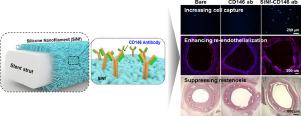Acta Biomaterialia ( IF 9.4 ) Pub Date : 2020-05-17 , DOI: 10.1016/j.actbio.2020.05.011 Kwang-Sook Park 1 , Sung Nam Kang 2 , Dae Hwan Kim 1 , Han-Byual Kim 3 , Kyung Seob Im 4 , Wooram Park 5 , Young Joon Hong 3 , Dong Keun Han 5 , Yoon Ki Joung 2

|
The restoration of damaged endothelium is promising to reduce side effects, including restenosis and thrombosis, in the stent treatment for vascular diseases. Current technologies based on drug delivery for these complications still do not satisfy patients due to invariant recurrence rate. Recently, even if one approach was applied to clinical trial to develop the firstly commercialized stent employing circulating endothelial progenitor cells (EPCs) in blood vessels, it resulted in failure in clinical trial. Based on instruction of the failed case, we designed an advanced EPC-capture stent covered with anti-CD146 antibody (Ab) immobilized silicone nanofilament (SiNf) for the highly efficient and specific capture of not early but late stage of EPCs. In vitro cell capture test demonstrates enhanced capture efficiency and adhesion morphology of late EPCs on the modified substrate. The modified substrates could capture 8 times more late EPCs and even 3 times more mesenchymal stem cells (MSCs) as compared to unmodified one. A porcine model with high similarity to human reproduced in vivo results ideally translated from in vitro cell capture results. As restenosis indicators, lumen area, neointimal rate and stenosis area for modified stents were reduced at the range of 30-60% as compared to those for bare metal stent (BMS). Fibrin score indicating thrombosis was lowered less than half as comparing to that on BMS. These inspiring results are attributed to ~2-fold increased endothelial coverage, determined by immuno-histological staining. Taken together, the CD146 Ab-armed nanofilamentous stent could show great performance in the reduction of thrombosis and restenosis through re-endothelialization due to highly efficient specific cell capture.
Statement of Significance
Stents have been developed from simple metal stents to functionalized stents for past decades. However, they have still risks to relapse the occlusion in stented arteries. In this paper, we describe the fabrication and optimization of cell capturing stents to maximize the effective re-endothelialization through the serial coating of silicone nanofilaments and anti-CD146 antibody. The nanofilaments increase the amount of coated antibodies and provide the anchoring points of circulating angiogenic cells for strong focal adhesion. We demonstrate high immobilizing ability of circulating angiogenic cells (endotheliali progenitor cells and mesenchymal stem cells) in vitro under similar shear stress to coronary arteries (15 dyne/cm2). Also, we show accelerating re-endothelialization and the efficient prevention of restenosis in porcine coronary arteries in vivo.
中文翻译:

具有CD146抗体和纳米结构的晚期内皮祖细胞捕获支架可减少支架内再狭窄和血栓形成。
在血管疾病的支架治疗中,受损内皮的修复有望减少副作用,包括再狭窄和血栓形成。由于复发率不变,目前基于药物递送的用于这些并发症的技术仍不能使患者满意。近来,即使将一种方法用于临床试验来开发首先在血管中使用循环内皮祖细胞(EPC)的商业化支架,也导致临床试验失败。根据失败案例的指示,我们设计了覆盖有抗CD146抗体(Ab)固定化有机硅纳米丝(SiNf)的先进EPC捕获支架,可高效,特异性地捕获EPC的早期而非晚期。体外细胞捕获测试表明,晚期EPC在改性基质上的捕获效率和粘附形态均得到增强。与未修饰的底物相比,修饰后的底物可以捕获的EPC数量多8倍,间充质干细胞(MSC)的数量甚至高3倍。与人体内复制高度相似的猪模型,理想的是从体外翻译而来细胞捕获结果。作为再狭窄的指标,与裸金属支架(BMS)相比,改良型支架的管腔面积,新内膜速率和狭窄面积减少了30-60%。与BMS相比,表明血栓形成的纤维蛋白评分降低了不到一半。这些令人鼓舞的结果归因于通过免疫组织学染色确定的内皮覆盖率增加了约2倍。综上所述,由于高效的特异性细胞捕获,CD146 Ab武装的纳米丝支架通过重新内皮化可以在减少血栓形成和再狭窄方面显示出出色的性能。
重要声明
几十年来,支架已从简单的金属支架发展为功能性支架。但是,它们仍然有复发覆膜动脉闭塞的风险。在本文中,我们描述了细胞捕获支架的制造和优化,以通过有机硅纳米丝和抗CD146抗体的连续涂层最大化有效的重新内皮化。纳米丝增加了包被抗体的量,并提供了循环血管生成细胞的锚定点,从而具有强的粘着力。我们证明循环血管生成细胞的高能力固定(endotheliali祖细胞和间充质干细胞)在体外类似剪切应力冠状动脉(15达因/厘米下2)。而且,我们显示出在体内猪冠状动脉的加速再内皮化和有效预防再狭窄。











































 京公网安备 11010802027423号
京公网安备 11010802027423号